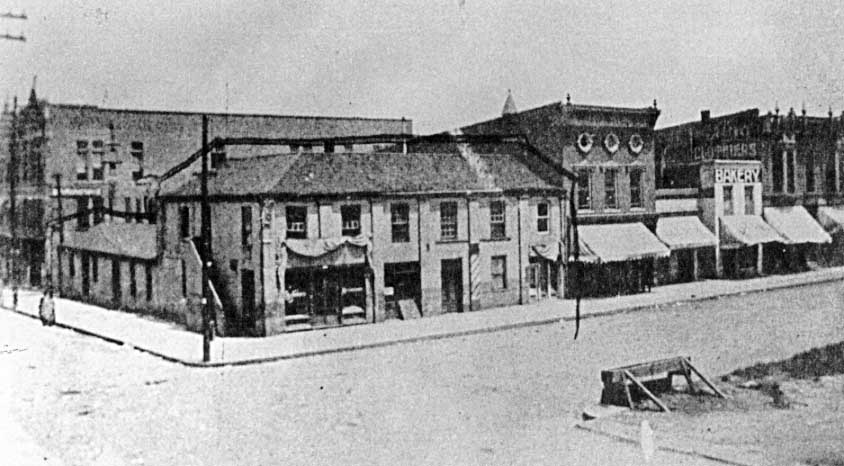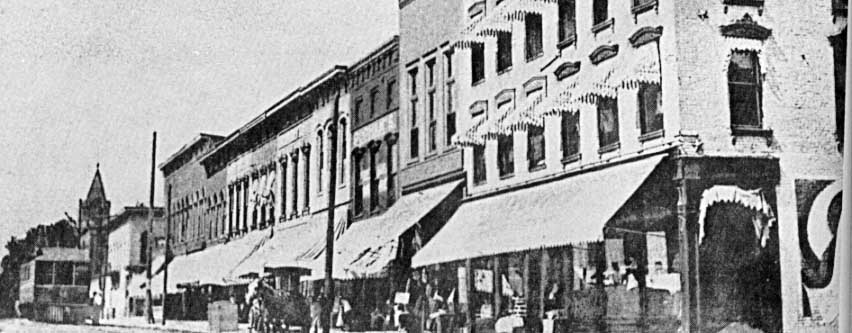Facades of Historic Charleston

Painted by muralist Glenn Davies of Urbana, this mural presents a panoramic view of historic architectural building fronts. Although the mural portrays the imagination of Davies, he has included historical and architectural details of Charleston's historic courthouse square. Many of the intricate details have been gathered from period photographs to depict a Charleston street scene from c. 1900-1920. A barber shop, a grocery store, and an entrance to a local chapter of the Independent Order of Odd Fellows - a typical lodge hall that would have been found in many downtown areas at that time. A confectionery and a millinery will be added to the mural in 2001. This mural provides a nice introduction into the history of the town's business activities and economy, which was dominated by the shops of the square for a long time.
The central courthouse square that developed in Charleston remained the political, social, and business center of the region from the city's beginnings well into the twentieth century. Business primarily, flourished on the square. The first couple of decades of settlement, (1830s and 1840s), resulted in a series of log structures downtown. Many were residential, but some of Charleston's first stores were amongst these buildings. The population quickly rose, as early Illinois newspapers bragged, "Any laboring man, with reasonable industry and economy, with a family, may arrive here without any capital, and in half a dozen years be the owner of a good farm, with stock in abundance." During that time, people gathered at the square to exchange news and gossip, and purchase or barter for goods.
The construction of the railroads through the region during the mid-1800s resulted in a rapid expansion of the local economy. The log buildings that dotted the square were gradually replaced with more stable wooden frame and brick structures. Just north of the square, the Big Four and Cloverleaf Railroad depots were bustling with activity. The railroads not only brought costumers, but also commercial goods for the businesses. Farmers also benefited from the railroads as they shipped their agricultural goods out. At that time, Charlestonians boasted that there was "a hotel on every corner" on the square.
 A view of the Capitol House Hotel (built in 1843) and some of the stores that lined the square. Photograph taken around 1898.
A view of the Capitol House Hotel (built in 1843) and some of the stores that lined the square. Photograph taken around 1898.
By the turn of the century (1900) and during the years before the outbreak of World War I, the businesses downtown thrived. A number of more specialized shops began to appear. By 1916, there were four drug stores, six dry good stores,  two jewelry stores, a department store, a clothing store, three shoe stores, a hardware store, a millinery store, a billiards and pool hall, a grocery store, confectionery, and two restaurants. The effects of the Industrial, Commercial, and Transportation revolutions became apparent in Charleston, where a consumer economy emerged, even though farming still remained very important in the region. This postcard (c. 1905) illustrates the prosperity of Charleston's downtown square during the turn of the century.
two jewelry stores, a department store, a clothing store, three shoe stores, a hardware store, a millinery store, a billiards and pool hall, a grocery store, confectionery, and two restaurants. The effects of the Industrial, Commercial, and Transportation revolutions became apparent in Charleston, where a consumer economy emerged, even though farming still remained very important in the region. This postcard (c. 1905) illustrates the prosperity of Charleston's downtown square during the turn of the century.
Today, the square remains the center for local government in Coles County, but it has lost its original commercial vitality. Many of the original buildings from the 1860s and 1870s were turn down and replaced during the early decades of the twentieth century. Some of those buildings, built during the early 1900s, still stand on the square (though most have lost much of there historic integrity through alterations). The construction of the highways (primarily Illinois-16 and Interstate-57), the founding of the Normal School (now Eastern Illinois University), and the advent of the automobile resulted in the emergence of commercial centers outside the square. Illinois-16 has become the commercial strip, while some of the buildings remain vacant downtown. Perhaps someday, the square will regain its original commercial activity.
This provides a brief look into the history of business on the square. There are many questions that can guide further research on this topic. For instance: In what other ways has the commercial activity of the square changed over time? How does the economic history of Charleston aid in understanding the area's past? How have innovations in transportation and communication affected Charleston's growth?









